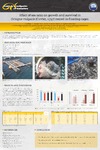Please use this identifier to cite or link to this item:
https://accedacris.ulpgc.es/jspui/handle/10553/5512
| DC Field | Value | Language |
|---|---|---|
| dc.contributor.author | Estefanell, J. | en_US |
| dc.contributor.author | Socorro Cruz, Juan Antonio | en_US |
| dc.contributor.author | Guirao Guijarro, Rafael | en_US |
| dc.contributor.author | Fernandez-Palacios, H. | en_US |
| dc.contributor.author | Izquierdo, Marisol | en_US |
| dc.contributor.author | Roo, Javier | en_US |
| dc.date.accessioned | 2011-05-27T02:31:00Z | |
| dc.date.accessioned | 2018-06-18T06:49:11Z | - |
| dc.date.available | 2011-05-27T04:00:16Z | |
| dc.date.available | 2018-06-18T06:49:11Z | - |
| dc.date.issued | 2010 | en_US |
| dc.identifier.uri | https://accedacris.ulpgc.es/handle/10553/5512 | - |
| dc.description.abstract | Octopus vulgaris is a potential candidate to diversify European aquaculture for its rapid growth and high market prices (Vaz Pires et al. 2004). One factor affecting industrial development of octopus culture is sexual maturation under rearing conditions. Octopus females can lose up to 30-60% of their initial body weight during egg-laying (Iglesias et al., 2000) and die after the paralarvae hatch (Guerra,1992), while a correlation between males death and spermatic sac depletion has being recently reported by Estefanell et al. (2010b). The present experiment discusses the effect of three different sex ratios on growth, sexual maturation and survival in O. Vulgaris. Conclusions: Discarded bogue from fish farms could be used as alternative diet for the final stage of O. vulgaris ongrowing ; Male segregation would maximize biomass increment ; Under the conditions described, sex ratios close to 1:1 produced higher biomass increment than 4:1 | en_US |
| dc.format | application/pdf | es |
| dc.language | eng | en_US |
| dc.rights | by-nc-nd | es |
| dc.source | Aquaculture Europe 2010, Porto, Portugal, october 5-8 | en_US |
| dc.subject | 251092 Acuicultura marina | en_US |
| dc.subject.other | Pulpo | en_US |
| dc.title | Effect of sex ratio on growth and survival in Octopus vulgaris (Cuvier, 1797) reared in floating cages | en_US |
| dc.type | info:eu-repo/semantics/conferenceobject | en_US |
| dc.type | Conference poster | en_US |
| dc.identifier.doi | 10.13140/2.1.3784.4489 | en_US |
| dc.identifier.absysnet | 628552 | - |
| dc.investigacion | Ciencias | en_US |
| dc.rights.accessrights | info:eu-repo/semantics/openAccess | es |
| dc.type2 | Póster de congresos | en_US |
| dc.identifier.ulpgc | Sí | es |
| item.grantfulltext | open | - |
| item.fulltext | Con texto completo | - |
| crisitem.author.dept | GIR Grupo de Investigación en Acuicultura | - |
| crisitem.author.dept | IU de Investigación en Acuicultura Sostenible y Ec | - |
| crisitem.author.dept | Departamento de Biología | - |
| crisitem.author.dept | GIR Grupo de Investigación en Acuicultura | - |
| crisitem.author.dept | IU de Investigación en Acuicultura Sostenible y Ec | - |
| crisitem.author.dept | Departamento de Biología | - |
| crisitem.author.orcid | 0000-0003-1410-8154 | - |
| crisitem.author.orcid | 0000-0003-4297-210X | - |
| crisitem.author.orcid | 0000-0002-9660-230X | - |
| crisitem.author.parentorg | IU de Investigación en Acuicultura Sostenible y Ec | - |
| crisitem.author.parentorg | IU de Investigación en Acuicultura Sostenible y Ec | - |
| crisitem.author.fullName | Fernández Palacios, Hipólito | - |
| crisitem.author.fullName | Izquierdo López, María Soledad | - |
| crisitem.author.fullName | Roo Filgueira, Francisco Javier | - |
| Appears in Collections: | Póster de congreso | |
Items in accedaCRIS are protected by copyright, with all rights reserved, unless otherwise indicated.
